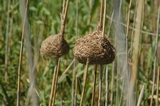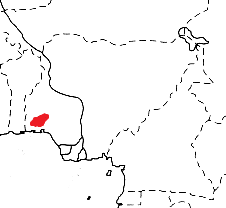Weaver species
Choose different species from drop-down list and press 'Go' button. See Full species list.Ibadan Malimbe Malimbus ibadanensis
IUCN: Endangered Discovery: 114Categories: long tube, Malimbus, fruit, IUCN, palm,
News items about species
Discovery
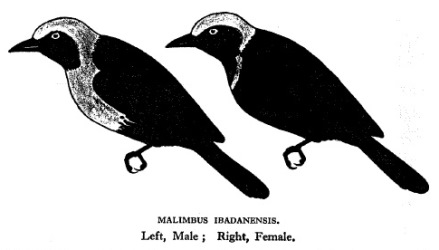
figure from Elgood 1958a 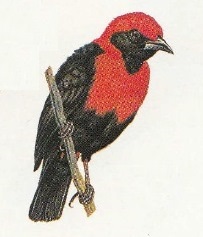
figure from Mackworth 1973a 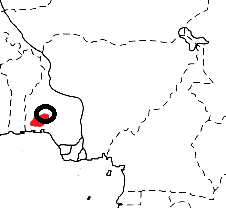
distribution, type locality circled IntroductionThe Ibadan Malimbe was first collected, and formally described, by John H Elgood, an English Professor of Zoology.Elgood first observed a pair of this malimbe at the University College, Ibadan, on 18 Dec 1951, and realised that it was different to the known species of malimbes. In 1958 he obtained specimens of this malimbe and was able to describe it as a new species. An adult female was obtained in a garden in Ibadan on 31 Jan 1958 by JH Elgood. An adult male was obtained at University College, Ibadan on 28 Feb 1958 by JH Elgood. Another male was found dead in an Ibadan garden on 15 May 1958 by JH Sutton. Two of the specimens had vegetable matter in their stomachs, consisting mainly of pieces of Oil-palm fruits. The third specimen also had many insect fragments, especially the wings of alate tailor-ants. Elgood also described a nest belonging to the Ibadan Malimbe. The nest was of the "inverted sock" type with an entrance tunnel about 30 cm long. It was placed near the top of a Bombax tree, some 20 m above the ground. The Ibadan Malimbe was first illustrated by Elgood 1958a as a line drawing of a pair of birds. This was followed by a line drawing by Elgood 1964a where the breast band of the female was correctly made wider. The first colour illustration was of a male, by Mackworth 1973a. Scientific citationMalimbus ibadanensis Elgood 1958a, Ibis 100 p.622, Ibadan, Eastern Nigeria.Meaning of namesibadanensis, Named after the city of Ibadan, Oyo, Nigeria.First English nameIbadan Weaver (Button 1964a).Alternate namesIbadan Weaver, Elgood's Malimbe.CollectorJH Elgood.Date collected28 Feb 1958.Locality collectedUniversity College, Ibadan, Nigeria.Type specimensThe types are in the British Museum (holotype BM 1958.9.2). |
The above is based on Weaver Wednesday 2, a weekly series about the discovery of each weaver species.
This species text first appeared as
Weaver Wednesday [231] - Discovery [114]: Ibadan Malimbe on 2016-11-16
1. Basic biology
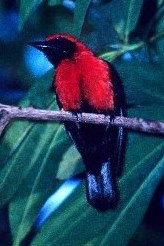
figure by A.P. Leventis The male Ibadan Malimbe is nearly identical to the male Cassin's Malimbe but their ranges do not overlap. The female Ibadan Malimbe is red on top of the head and has a narrow red collar and breast-band while the female Cassin's Malimbe has a black head, and the female Red-vented Malimbe has a black head and neck. The juvenile is sooty, with a dull orange breast-band, dark red-brown face patch, and tawny chin and throat. Distribution.
The Ibadan Malimbe is found in SW Nigeria (see map below, based on Birds of Africa).
Habitat. The Ibadan Malimbe inhabits forest patches, forest edges, secondary forest and woodland, often along tracks and openings in the forest. It also visits gardens and cultivated areas. Recent observations of foraging birds suggest a possible link with the kola tree Cola gigantea. Food.
The diet of the Ibadan Malimbe includes insects, caterpillars, winged ants, alate termites and palm nuts. It forages primarily in the middle storey, searching leaves, flowers, and dry pods and leaf clusters. The Ibadan Malimbe does not cling to tree trunks like the nuthatch-weavers. It occurs in pairs or in small groups, and often joins mixed-species flocks with other forest weavers or birds.
Breeding. The Ibadan Malimbe is monogamous and a solitary nester. The nest resembles an inverted sock, and has an entrance tunnel 20-25 cm long. The nest is woven from strips of palm leaves and tendrils of climbing plants. One male worked on two separate nests and the female lined one of them. In one case a second male assisted the primary male in nest construction. The nest is placed 12-20 m above the ground near the tip of a branch of a mature forest tree. Nests may be close to active wasp nests, or in the same tree as Red-headed Malimbe and Fork-tailed Drongo nests. The Ibadan Malimbe may be suffering from nesting competition by other malimbes, weavers or drongos that also nest in mature forest trees. The eggs (clutch 1-2 eggs) are pale greenish-white with small dark brown spots and underlying lilac shading. Incubation is by the female, and chicks are fed by both parents. |
The above is based on Weaver Wednesday, a weekly series about weaver species.
This species text first appeared as
Weaver Wednesday [116]: Ibadan Malimbe on 2014-09-03
2. Breeding facts
| Pair bond Monogamous Breeding season mainly May-Aug, but nesting recorded also in Feb, Sept, Oct and Dec Nest site placed 12-20 m above ground near tip of branch of mature forest tree Nest building in one case male worked on two separate nests and female lined one of these, at another nest second male assisted in construction Colony size no information Clutch size 1-2 eggs Egg colour pale greenish-white with small irregular spots and underlying lilac shading Egg size one egg 23 x 15 mm Incubation incubation by female, estimated period 14 days Chicks and nestling period chicks fed by both male and female, estimated nestling period at least 14 days |
Breeding information based on Handbook of the Birds of the World, Vol. 15.
3. Photos of Weaver Nests
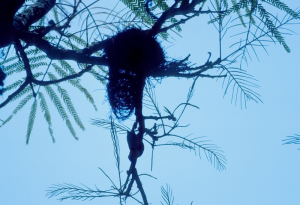 Vm 13822 | 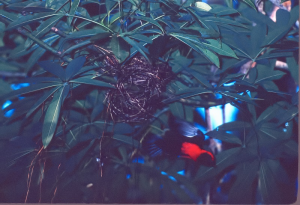 Vm 13821 |
Thumb-nails of most recent PHOWN records - click on one to see its full record
See all PHOWN records for this species here.
PHOWN (Photos of Weaver Nests) provides valuable info on breeding distribution and colony sizes of weavers.
You can contribute by registering and submitting photos at Virtual Museum webpage.
4. Breeding distribution
Google map showing distribution (For species with small ranges you need to zoom in at the correct area to see the range):
yellow blob - range of weaver species; read more about this here.
![]() - PHOWN records with photos
- PHOWN records with photos
![]() - PHOWN records with no photos (Nest Record Cards, other records)
- PHOWN records with no photos (Nest Record Cards, other records)
![]() - Birdpix records
- Birdpix records
![]() - comments on out of range records, or interesting records
- comments on out of range records, or interesting records
![]() - type locality
- type locality
CLICK on the marker on the map to see individual record details.
5. Range changes
Not South African speciesThe above is based on Weaver Wednesday 3, a weekly series about range changes in South African weaver species.
This species text first appeared as
n/a








